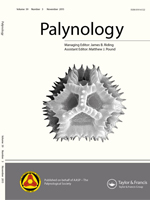Fossil dinoflagellate cysts of the Paleogene peridiniacean subfamily Wetzelielloideae have a stable tabulation pattern similar to that of other fossil peridiniaceans, but distinguished by a four-sided (quadra) rather than a six-sided (hexa) 2a plate. Aside from tabulation, wetzelielloideans show great morphological variability, especially in ornamentation and horn development, but also in wall structure. This diversity has distracted attention from the morphological variation of the archeopyle, which, although always formed through loss of the 2a plate only, shows variations that we consider critical in unravelling the group's phylogeny. Important factors are the shape and relative dimensions of the archeopyle and whether the operculum is attached (adnate) or detached. These parameters allow us to define five archeopyle types: equiepeliform, hyperepeliform, hypersoleiform, latiepeliform and soleiform. Based primarily on archeopyle type and secondarily on wall morphology and ornamentation, we recognise six genera with an equiepeliform archeopyle, four with a hyperepeliform archeopyle, five with a latiepeliform archeopyle, five with a soleiform archeopyle and one with a hypersoleiform archeopyle. The earliest known wetzelielloideans, which occur around the Paleocene—Eocene boundary, have an equiepeliform archeopyle. Other archeopyle types evolved rapidly: taxa with hyperepeliform, latiepeliform and hypersoleiform types are known from the Ypresian. Latiepeliform and hyperepeliform types are restricted to the Ypresian and Lutetian. Forms with the soleiform archeopyle appeared in the late Lutetian, but were rare until the Bartonian, when they became the dominant type, and they were the only type in Priabonian and younger strata. Wetzelielloideans became extinct in the middle Oligocene. We make numerous taxonomic proposals, including the following new genera: Castellodinium, Dolichodinium, Epelidinium, Kledodinium, Michouxdinium, Petalodinium, Piladinium, Rhadinodinium, Sagenodinium, Sophismatia, Stenodinium, Stichodinium and Vallodinium. We emend the diagnoses of Charlesdowniea, Dracodinium and Wilsonidium, and erect the species Kledodinium filosum, Petalodinium sheppeyense and Sagenodinium franciscanum.
How to translate text using browser tools
1 November 2015
Wetzeliella and Its Allies — The ‘Hole’ Story: A Taxonomic Revision of the Paleogene Dinoflagellate Subfamily Wetzelielloideae
Graham L. Williams,
Sarah P. Damassa,
Robert A. Fensome,
G. Raquel Guerstein
ACCESS THE FULL ARTICLE
It is not available for individual sale.
This article is only available to subscribers.
It is not available for individual sale.
It is not available for individual sale.

Palynology
Vol. 39 • No. 3
November 2015
Vol. 39 • No. 3
November 2015
biostratigraphy
Dinoflagellate cysts
evolution
Paleogene
taxonomy
wetzelielloideans




